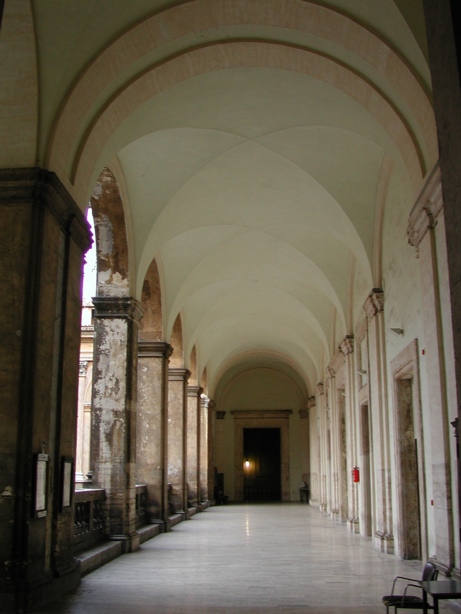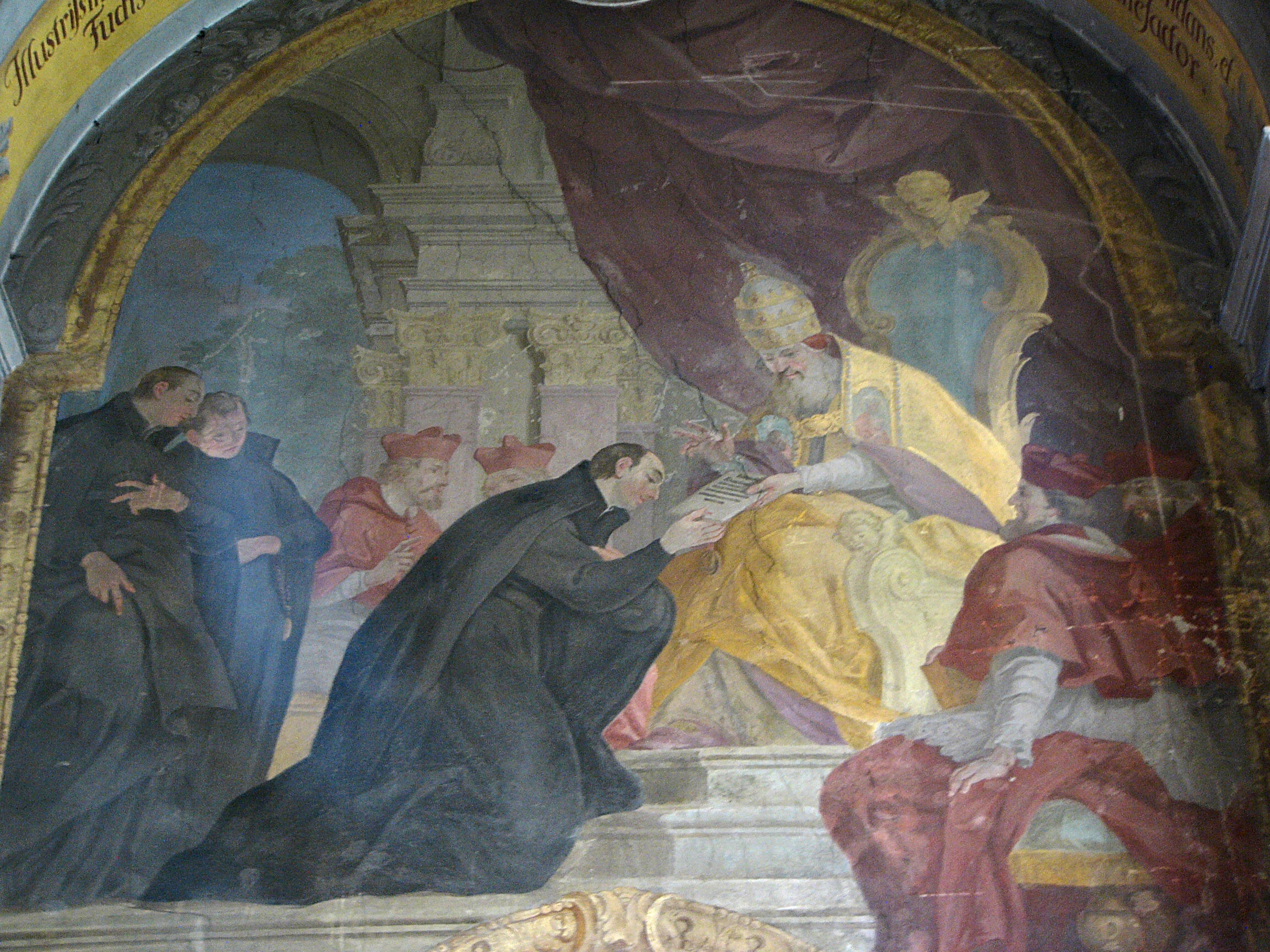|
Filippo Buonanni
Filippo Bonanni; S.J. or Buonanni (7 January 1638 – 30 March 1723) was an Italian Jesuit scholar. His many works included treatises on fields ranging from anatomy to music. He created the earliest practical illustrated guide for shell collectors in 1681, for which he is considered a founder of conchology. He also published a study of lacquer that has been of lasting value since his death. Life Bonanni was born in Rome in 1638, and entered the Society of Jesus in 1654, when he was still 17 years old. After his novitiate, in 1656 he was sent to study at the Society's noted Roman College. There he became a pupil of the German scientist, Athanasius Kircher. While a student there, he undertook the manufacturing of microscopic lenses. He used his lenses to create his own microscope and to develop scientific studies of a number of specimens. He also became a skilled copper plate engraver. From Rome, Bonanni was sent to teach in the Jesuit Colleges of Orvieto and Ancona. Upo ... [...More Info...] [...Related Items...] OR: [Wikipedia] [Google] [Baidu] |
Serpent (instrument)
The serpent is a low-pitched early brass instrument developed in the Renaissance era with a trombone-like mouthpiece and tone holes (later with keys) like a woodwind instrument. It is named for its long, conical bore bent into a snakelike shape, and unlike most brass instruments is generally made from wood, usually walnut, and covered with dark brown or black leather. A distant ancestor of the tuba, the serpent is related to the cornett and was used for bass parts from the 17th to the early 19th centuries. Characteristics Although closely related to the cornett, the serpent has thinner walls, a more conical bore, and no thumb-hole. The serpent is typically built in eight-foot C with six fingerholes, in two groups of three. Early serpents were keyless, while later instruments added keys for additional holes out of reach of the fingers, to improve intonation and extend range. There is no real standard for the serpent's range, which varies according to the instrument and the playe ... [...More Info...] [...Related Items...] OR: [Wikipedia] [Google] [Baidu] |
Optics
Optics is the branch of physics that studies the behaviour and properties of light, including its interactions with matter and the construction of instruments that use or detect it. Optics usually describes the behaviour of visible, ultraviolet, and infrared light. Because light is an electromagnetic wave, other forms of electromagnetic radiation such as X-rays, microwaves, and radio waves exhibit similar properties. Most optical phenomena can be accounted for by using the classical electromagnetic description of light. Complete electromagnetic descriptions of light are, however, often difficult to apply in practice. Practical optics is usually done using simplified models. The most common of these, geometric optics, treats light as a collection of rays that travel in straight lines and bend when they pass through or reflect from surfaces. Physical optics is a more comprehensive model of light, which includes wave effects such as diffraction and interference that cannot be ... [...More Info...] [...Related Items...] OR: [Wikipedia] [Google] [Baidu] |
Orvieto
Orvieto () is a city and ''comune'' in the Province of Terni, southwestern Umbria, Italy, situated on the flat summit of a large butte of volcanic tuff. The city rises dramatically above the almost-vertical faces of tuff cliffs that are completed by defensive walls built of the same stone, called ''tufa''. History Etruscan era The ancient city (''urbs vetus'' in Latin, whence "Orvieto"), populated since Etruscan times, has usually been associated with Etruscan Velzna, but some modern scholars differ. Orvieto was certainly a major centre of Etruscan civilization; the archaeological museum (Museo Claudio Faina e Museo Civico) houses some of the Etruscan artifacts that have been recovered in the immediate area. A tomb in the Orvieto Cannicella necropolis bears the inscription ''mi aviles katacinas'', "I am of Avile Katacina"; the tomb's occupant thus bore an Etruscan-Latin first name, Aulus, and a family name that is believed to be of Celtic origin (derived from "Catacos"). Th ... [...More Info...] [...Related Items...] OR: [Wikipedia] [Google] [Baidu] |
Collegio Romano
The Roman College ( la, Collegium Romanum, it, Collegio Romano) was a school established by St. Ignatius of Loyola in 1551, just 11 years after he founded the Society of Jesus (Jesuits). It quickly grew to include classes from elementary school through university level and moved to several successive locations to accommodate its burgeoning student population. With the patronage of Pope Gregory XIII, the final seat of the Roman College was built in 1584 near the center of Rome's most historic Pigna district, on what today is called Piazza del Collegio Romano, adding the church of St. Ignatius in 1626, and a renowned observatory in 1787. The college remained at this location for 286 years until the revolutionary Capture of Rome in 1870.In 1870, the new Italian government confiscated the property of the university and their building (that eventually became the Ennio Quirino Visconti Liceo Ginnasio), which forced the university to transfer to the Palazzo Gabrielli-Borromeo on the ... [...More Info...] [...Related Items...] OR: [Wikipedia] [Google] [Baidu] |
Novitiate
The novitiate, also called the noviciate, is the period of training and preparation that a Christian ''novice'' (or ''prospective'') monastic, apostolic, or member of a religious order undergoes prior to taking vows in order to discern whether they are called to vowed religious life. It often includes times of intense study, prayer, living in community, studying the vowed life, deepening one's relationship with God, and deepening one's self-awareness. The canonical time of the novitiate is one year; in case of additional length, it must not be extended over two years.CIC, canon 648 In the Eastern Orthodox Church, the novitiate is officially set at three years before one may be tonsured a monk or nun, though this requirement may be waived. The novitiate is in any case a time both for the novice to get to know the community and the community to get to know the novice. The novice should aspire to deepening their relationship to God and discovering the community's charism. The novit ... [...More Info...] [...Related Items...] OR: [Wikipedia] [Google] [Baidu] |
Filippo Buonanni 1723 Traité Des Vernis
Filippo is an Italian male given name, which is the equivalent of the English name Philip, from the Greek ''Philippos'', meaning "amante dei cavalli".''Behind the Name''"Given Name Philip" Retrieved on 23 January 2016. The female variant is Filippa. The name may refer to: *Filippo I Colonna (1611–1639), Italian nobleman *Filippo II Colonna (1663–1714), Italian noblemen *Filippo Abbiati (1640–1715), Italian painter *Filippo Baldinucci (1624–1697), Italian historian *Filippo Brunelleschi (1377–1446), Italian architect *Filippo Carli (1876–1938), Italian sociologist *Filippo Castagna (1765–1830), Maltese politician *Filippo Coarelli (born 1936), Italian archaeologist *Filippo Coletti (1811–1894), Italian singer *Filippo di Piero Strozzi (1541–1582), French general *Filippo Salvatore Gilii (1721–1789), Italian priest and linguist *Filippo Grandi (born 1957), Italian diplomat * Filippo Illuminato (1930-1943), Italian partisan, recipient of the Gold Medal of Military ... [...More Info...] [...Related Items...] OR: [Wikipedia] [Google] [Baidu] |
Illustrations Of Various Sea Shells Wellcome L0060694
An illustration is a decoration, interpretation or visual explanation of a text, concept or process, designed for integration in print and digital published media, such as posters, flyers, magazines, books, teaching materials, animations, video games and films. An illustration is typically created by an illustrator. Digital illustrations are often used to make websites and apps more user-friendly, such as the use of emojis to accompany digital type. llustration also means providing an example; either in writing or in picture form. The origin of the word "illustration" is late Middle English (in the sense ‘illumination; spiritual or intellectual enlightenment’): via Old French from Latin ''illustratio''(n-), from the verb ''illustrare''. Illustration styles Contemporary illustration uses a wide range of styles and techniques, including drawing, painting, printmaking, collage, montage, digital design, multimedia, 3D modelling. Depending on the purpose, illustra ... [...More Info...] [...Related Items...] OR: [Wikipedia] [Google] [Baidu] |
Lacquer
Lacquer is a type of hard and usually shiny coating or finish applied to materials such as wood or metal. It is most often made from resin extracted from trees and waxes and has been in use since antiquity. Asian lacquerware, which may be called "true lacquer", are objects coated with the treated, dyed and dried sap of ''Toxicodendron vernicifluum'' or related trees, applied in several coats to a base that is usually wood. This dries to a very hard and smooth surface layer which is durable, waterproof, and attractive in feel and look. Asian lacquer is sometimes painted with pictures, inlaid with shell and other materials, or carved, as well as dusted with gold and given other further decorative treatments. In modern techniques, lacquer means a range of clear or pigmented coatings that dry by solvent evaporation to produce a hard, durable finish. The finish can be of any sheen level from ultra matte to high gloss, and it can be further polished as required. Lacquer finishes ... [...More Info...] [...Related Items...] OR: [Wikipedia] [Google] [Baidu] |
Conchology
Conchology () is the study of mollusc shells. Conchology is one aspect of malacology, the study of molluscs; however, malacology is the study of molluscs as whole organisms, whereas conchology is confined to the study of their shells. It includes the study of land and freshwater mollusc shells as well as seashells and extends to the study of a gastropod's operculum. Conchology is now sometimes seen as an archaic study, because relying on only one aspect of an organism's morphology can be misleading. However, a shell often gives at least some insight into molluscan taxonomy, and historically the shell was often the only part of exotic species that was available for study. Even in current museum collections it is common for the dry material (shells) to greatly exceed the amount of material that is preserved whole in alcohol. Conchologists mainly deal with four molluscan orders: the gastropods (snails), bivalves (clams), Polyplacophora (chitons) and Scaphopoda (tusk shells). Ce ... [...More Info...] [...Related Items...] OR: [Wikipedia] [Google] [Baidu] |
Jesuit
, image = Ihs-logo.svg , image_size = 175px , caption = ChristogramOfficial seal of the Jesuits , abbreviation = SJ , nickname = Jesuits , formation = , founders = , founding_location = , type = Order of clerics regular of pontifical right (for men) , headquarters = Generalate:Borgo S. Spirito 4, 00195 Roma-Prati, Italy , coords = , region_served = Worldwide , num_members = 14,839 members (includes 10,721 priests) as of 2020 , leader_title = Motto , leader_name = la, Ad Majorem Dei GloriamEnglish: ''For the Greater Glory of God'' , leader_title2 = Superior General , leader_name2 = Fr. Arturo Sosa, SJ , leader_title3 = Patron saints , leader_name3 = , leader_title4 = Ministry , leader_name4 = Missionary, educational, literary works , main_organ = La Civiltà Cattolica ... [...More Info...] [...Related Items...] OR: [Wikipedia] [Google] [Baidu] |
Society Of Jesus
, image = Ihs-logo.svg , image_size = 175px , caption = ChristogramOfficial seal of the Jesuits , abbreviation = SJ , nickname = Jesuits , formation = , founders = , founding_location = , type = Order of clerics regular of pontifical right (for men) , headquarters = Generalate:Borgo S. Spirito 4, 00195 Roma-Prati, Italy , coords = , region_served = Worldwide , num_members = 14,839 members (includes 10,721 priests) as of 2020 , leader_title = Motto , leader_name = la, Ad Majorem Dei GloriamEnglish: ''For the Greater Glory of God'' , leader_title2 = Superior General , leader_name2 = Fr. Arturo Sosa, SJ , leader_title3 = Patron saints , leader_name3 = , leader_title4 = Ministry , leader_name4 = Missionary, educational, literary works , main_organ = La Civiltà Cattoli ... [...More Info...] [...Related Items...] OR: [Wikipedia] [Google] [Baidu] |







